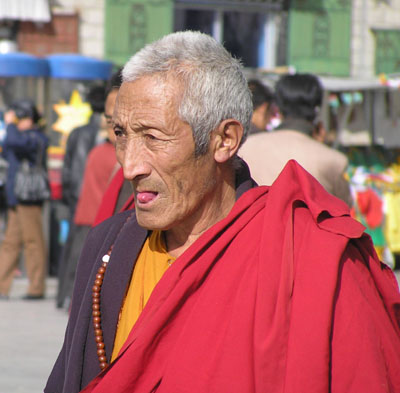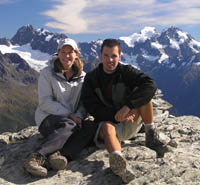The Forbidden City
Walking down the streets of Lhasa is an unforgettable experience. Pilgrims hustle around the holy koras (devotional pilgrimage circuits), spinning their ever-moving prayer wheels, and occasionally prostrating (repeatedly standing, kneeling, and then lying face down on the ground, with eyes closed, praying to Buddha). Men haggle over huge hind-quarters of raw yak meat stacked high on the sidewalk. Monks gather in groups, chanting Buddhist mantras. Nomads from the high plateau gaze at the Potala in awe, the fur on their hats waving in the wind. Vendors hawk everything from Tibetan prayer flags to jewel-encased yak skulls to fake North Face Jackets. The mind can’t possibly absorb it all.

To make matters worse, sounds and smells assault the senses. Wafting incense mixes with the smell of beggars, yak-oil cooking, raw sewage, and the ever-present yak-butter lamps. The peaceful chanting of prayer is routinely drowned out by blaring low-fidelity Chinese music, the constant honking of car horns, the ringing of pedicab bells, and the yelling of street vendors in both Tibetan and Mandarin.
Lhasa sits at 11,800 feet, in a high valley surrounded by towering mountains. The crown of Lhasa is the immense ochre and whitewashed Potala Palace soaring high over the center of the city. Over 400 years old, the Potala is traditionally the home to the spiritual leader of all Tibetan Buddhists, the Dalai Lama. Since the Dalai Lama was forced to flee Tibet, the Potala sits dormant, a sobering museum-relic and constant reminder of the high altitude country’s troubled times.
In contrast, the spiritual heart of the city, the Jokhang, hums with activity just a few blocks away. The Jokhang is the most revered and active of Tibet’s temples. It is encased by the Barkhor, Tibet’s most famous holy pilgrimage circuit. The Barkhor is a constant river of motion, as thousands of pilgrims flow clockwise around the cobbled circuit at all hours of the day. While the masses swirl around the Barkhor, the front of the Jokhang turns into a massive sea of worship, with pilgrims prostrating for hours on end. Chants mix with incense and the smell of burning yak butter, before drifting away in the high mountain air.
Lhasa may not the magical place it was once reputed to be. Tibet’s troubles are well known, and our impression of the current situation deserves its own post in the future. However, Lhasa is still one of the most amazing places we have ever been. The Tibetan people and culture are so remarkable, and the mystique and history of Tibet is so amazing, that we feel very fortunate to see Tibet with our own eyes before it is completely assimilated into Chinese culture.
Enjoy the Lhasa, Tibet Photo Gallery.
Enjoy the video of prostrating pilgrims.

Beautiful pictures and stunning scenery!
Heather
Post a Comment
<< Home